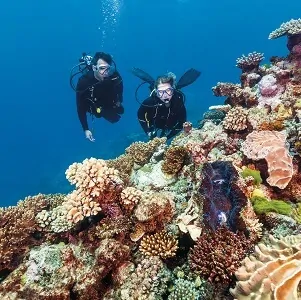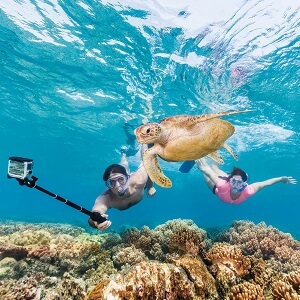Get ready for your Great Barrier Reef adventure with our tips and tricks on how to scuba dive.
One of the best ways to see the Great Barrier Reef is by scuba diving! Sink to the depths of this underwater wonderland and explore the vast maze of coral and marine life. It is an unforgettable experience that is well worth the expense, letting you fully immerse yourself in the underwater world without having to worry about heading to the surface to gulp for air. Here are our tips and tricks for making your first scuba diving experience go as smoothly as possible!
The Scuba Diving Basics
Scuba diving can take some getting used to if you are a first timer! Unlike snorkelling, scuba diving allows guests to stay underwater for prolonged periods, using an oxygen tank to breathe. This allows the underwater explorers to swim along the ocean floor and among the corals and discover things they might have missed if snorkelling. Even if you aren’t the most confident swimmer, scuba diving can be easy! And with your experienced guide leading you through your introductory dive, you can feel safe and happy and able to enjoy this amazing experience.
How you are taught during the tour
Baby steps are the key to getting scuba diving correct. When completing a full dive certification, your first intro lesson is usually in a pool, not open water. However, for our beginner dive tours, a simple intro lesson on board the boat gives you all the information you’ll need for the day. You will go through a step by step process of equipment preparation and learn the basic skills of how to handle yourself in the water!
When you are ready to jump in the water, a certified divemaster will be with you all the way to ensure you are comfortable and safe for your dive experience. You’ll head to a maximum depth of eight metres underwater, giving a unique perspective of the reef and its inhabitants.
What you will wear
Gear is crucial for scuba diving, as a faulty set of goggles or fins can turn your experience into a fiasco. Everyone is equipped with a wetsuit, oxygen tank, regulator, googles, and flippers. All you need to bring is your own bathers which you will wear underneath the equipment. Once you start swimming, you’ll only need to focus on two aspects of your equipment, your goggles and your oxygen mouthpiece. The goggles are usually the hardest part to master, with special techniques to clear them from water and to avoid fogging. Make sure to practise these techniques above water prior to plunging into the reef, so that you feel confident when you’re beneath the waves.
Important things to remember
Scuba diving can be a fantastic experience, but it should not be taken lightly. Due to the water pressure you experience, waiting 24 hours before flying is a crucial rule. The difference between the underwater pressure and air pressure, as well as the excess nitrogen absorbed during your dive, can affect your body greatly.
Another safety measure that must be completed is the scuba diving medical questionnaire. Breathing issues, ear injuries, or pregnancy can all have an impact on a person’s eligibility to dive so make sure to double check the list before booking your dive!
What you will see at the Great Barrier Reef
Simply put, scuba diving along the Great Barrier Reef is worth all the effort! Head out in the early hours of the morning and set off to one of the 2,900 individual coral reefs scattered about. Here travellers are met with wonderous sights, including an array of brightly coloured corals and unique marine animals. Tours normally visit multiple reef spots, where you can see anything from sea turtles to tropical fish and even dolphins!
Related article: A beginner’s guide to snorkelling the Great Barrier Reef






